Gap filler
CIMMYT E-News, vol 3 no. 3, March 2006
Triticale finds a niche in Bangladesh
“This is just what I was looking for,” says Al Mahmoud Hasan, a farmer near the town or Rangpur in Bangladesh. “I wanted a crop to fill the fallow gap between the rice crops.”
In Bangladesh rice is king, with farmers often growing two rice crops a year. Now, in a pilot project funded by the Danish development agency, Danida, a new crop is making its debut. The aim of the on-farm trials is to see if triticale can make a difference in the lives of Bangladeshi farm families who keep dairy cattle.
Triticale is a cross between wheat and rye that CIMMYT researchers and partners have improved and promoted over recent decades. It makes good animal fodder because its leaves and stem are high in protein. In Bangladesh triticale was virtually unknown. Cows can eat Napier grass when it is in season but feed mostly on a diet of dry rice straw, a poor quality fodder. CIMMYT researchers realized that even in the intense cropping system in Bangladesh, there might be room for triticale as a high-quality cattle forage, filling a gap in the cropping season and a gap in cattle diets.
During the rainy season virtually every farmer in Bangladesh grows aman or monsoon rice. Then during the dry season they usually grow another rice crop (called boro), wheat, or even tobacco. Triticale can fit that second crop niche. The idea is to plant triticale as early as possible after the rice harvest and then cut it at 30 days and again at 50 days. The green cuttings are used as fodder. When the crop does mature, the grain can be used to feed chickens or ground and combined with wheat flour for Chapatti, the standard flat bread of south Asia.
Rokeya Begum has cash and 20% more milk from triticale-fed cows.Farmers who grow two full rice crops also have an option with triticale. That is because there is a 60 day fallow period between the two rice crops. It isn’t enough time for triticale to mature and produce grain, but it is long enough to produce good green fodder. That is exactly what Al Mahmoud Hasan is doing. He and his family were among 120 households participating in the trials throughout Bangladesh. He, his wife and his two oldest children received instruction in triticale cultivation as part of a whole family training system organized by CIMMYT and partners.
Participation and training has paid off for other farmers, including Rokeya Begum and her family. She sold her first triticale cut to neighbors and used the money to buy new clothes for an important religious festival. Mrs Begum also says her cows are giving 20% more milk on triticale than they did on a diet of rice straw.
The triticale seed for the trials came from CIMMYT in Mexico. The one-year pilot project is near its end and the data are not yet analyzed but reports from participating farmers are encouraging. Many like Mrs. Begum say their neighbors will buy seed from them for next season so they too can try triticale.
For further information contact Stephen Waddington (s.waddington@cgiar.org)
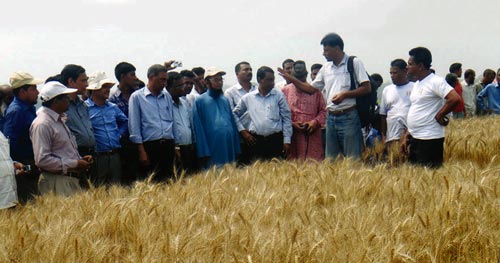
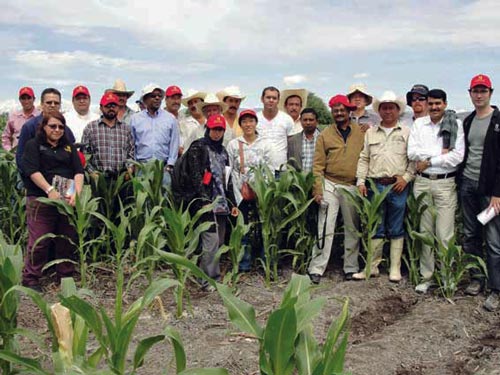 “It is very difficult to find conservation agriculture machinery. You have to go to China or India to get it,” said Mahesh Kumar Gathala, new CIMMYTBangladesh-based cropping systems agronomist for South Asia. Gathala, a native of India, was just one of the 15 participants invited to attend a five-week conservation agriculture course at CIMMYT-El Batán, Mexico, where improving machinery and professional capacity were hot topics.
“It is very difficult to find conservation agriculture machinery. You have to go to China or India to get it,” said Mahesh Kumar Gathala, new CIMMYTBangladesh-based cropping systems agronomist for South Asia. Gathala, a native of India, was just one of the 15 participants invited to attend a five-week conservation agriculture course at CIMMYT-El Batán, Mexico, where improving machinery and professional capacity were hot topics.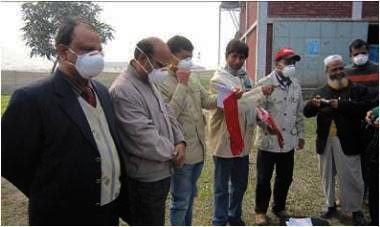 In Bangladesh, approximately 350 species of weeds have been identified, and in Asian countries, these weeds cause roughly 33% of total crop loss. Because of the threat posed by weeds, the use of herbicides in Bangladesh has risen rapidly in the past few years. Herbicides are a great asset to protect crops from weeds; however when not used properly, they can be dangerous to human health or lead to the premature development of herbicide-resistant weeds.
In Bangladesh, approximately 350 species of weeds have been identified, and in Asian countries, these weeds cause roughly 33% of total crop loss. Because of the threat posed by weeds, the use of herbicides in Bangladesh has risen rapidly in the past few years. Herbicides are a great asset to protect crops from weeds; however when not used properly, they can be dangerous to human health or lead to the premature development of herbicide-resistant weeds.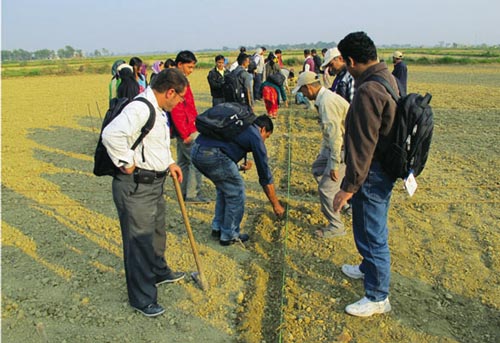 The Wheat Research Center (WRC) in Bhairahawa welcomed 20 early and mid-career wheat breeders from four CSISA countries (Bangladesh, India, Nepal, and Pakistan) to its scenic campus in Nepal’s Terai region to participate in a two-week regional Wheat Improvement and Pathology course which was organized in collaboration with Nepal Agricultural Research Council (NARC) from 29 November- 12 December 2010.
The Wheat Research Center (WRC) in Bhairahawa welcomed 20 early and mid-career wheat breeders from four CSISA countries (Bangladesh, India, Nepal, and Pakistan) to its scenic campus in Nepal’s Terai region to participate in a two-week regional Wheat Improvement and Pathology course which was organized in collaboration with Nepal Agricultural Research Council (NARC) from 29 November- 12 December 2010. On 30 June 2010, a USAID Famine Seed Project meeting was organized at CIMMYT’s South Asia Office in Kathmandu, Nepal. Seventeen participants, including those from the Nepal Agriculture Research Council (NARC), CIMMYT-Nepal, CIMMYT-Bangladesh, and Cereal Systems Initiative for South Asia (CSISA) HUB partners in Nepal, attended the meeting. The objectives of the day were to: (1) review 2009-10 crop cycle work and progress, (2) to develop a work plan for the upcoming 2010-11 cycle and, (3) to strengthen collaboration with technology-delivering stakeholders.
On 30 June 2010, a USAID Famine Seed Project meeting was organized at CIMMYT’s South Asia Office in Kathmandu, Nepal. Seventeen participants, including those from the Nepal Agriculture Research Council (NARC), CIMMYT-Nepal, CIMMYT-Bangladesh, and Cereal Systems Initiative for South Asia (CSISA) HUB partners in Nepal, attended the meeting. The objectives of the day were to: (1) review 2009-10 crop cycle work and progress, (2) to develop a work plan for the upcoming 2010-11 cycle and, (3) to strengthen collaboration with technology-delivering stakeholders. Over 60 researchers, field technicians, farmers, machinery manufacturers, service providers, and extension workers attended two recent conservation agriculture (CA) training events in Bangladesh. The first event was held at the Bangladesh Agriculture Research Institute (BARI) station in Comilla on 28-29 April, followed by an event at the Wheat Research Centre of BARI in Dinajpur on 04-05 May. The events focused on machinery operation and maintenance, as well as the agronomy of dry direct-seeded rice (DSR). Both were part of joint CIMMYT-
Over 60 researchers, field technicians, farmers, machinery manufacturers, service providers, and extension workers attended two recent conservation agriculture (CA) training events in Bangladesh. The first event was held at the Bangladesh Agriculture Research Institute (BARI) station in Comilla on 28-29 April, followed by an event at the Wheat Research Centre of BARI in Dinajpur on 04-05 May. The events focused on machinery operation and maintenance, as well as the agronomy of dry direct-seeded rice (DSR). Both were part of joint CIMMYT-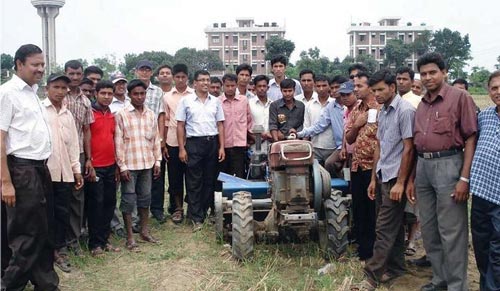 “Machinery operation and maintenance is vital for rapid dissemination of CA-based technologies,” said Jagadish Timsina, IRRI-CIMMYT senior cropping system agronomist. He added that this ACIAR-funded ricemaize project has been adapting and evaluating the PTOS and the bed former/planter at project sites, and has been refining these machines for their use in different soils with the help of agriculture engineers from the national agriculture research intuitions involved in the project. The project has given special emphasis to training and capacity building for machine use and has already trained more than 120 people from government and non-governmental organizations, as well as farmers, service providers, machinery manufacturers, and extension workers since it started in November 2008.
“Machinery operation and maintenance is vital for rapid dissemination of CA-based technologies,” said Jagadish Timsina, IRRI-CIMMYT senior cropping system agronomist. He added that this ACIAR-funded ricemaize project has been adapting and evaluating the PTOS and the bed former/planter at project sites, and has been refining these machines for their use in different soils with the help of agriculture engineers from the national agriculture research intuitions involved in the project. The project has given special emphasis to training and capacity building for machine use and has already trained more than 120 people from government and non-governmental organizations, as well as farmers, service providers, machinery manufacturers, and extension workers since it started in November 2008. Various research and extensions workers collaborating with the project “Sustainable Intensification of Rice-Maize Systems in Bangladesh” organized five farmer field days throughout March and April 2010. The events took place in the districts of Comilla, Rangpur, and Rajshahi and attracted over 350 farmers.
Various research and extensions workers collaborating with the project “Sustainable Intensification of Rice-Maize Systems in Bangladesh” organized five farmer field days throughout March and April 2010. The events took place in the districts of Comilla, Rangpur, and Rajshahi and attracted over 350 farmers.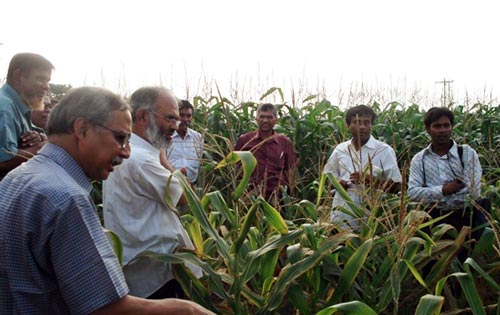 Though the project, which started in November 2008, initially focused on adaptive research in farmers’ fields, it is now starting to emphasize dissemination of improved CA practicies and SSNM technologies to farmers as well. This will be done through training and capacity building with researchers, farmers, extension workers, machinery manufacturers, and service providers.
Though the project, which started in November 2008, initially focused on adaptive research in farmers’ fields, it is now starting to emphasize dissemination of improved CA practicies and SSNM technologies to farmers as well. This will be done through training and capacity building with researchers, farmers, extension workers, machinery manufacturers, and service providers.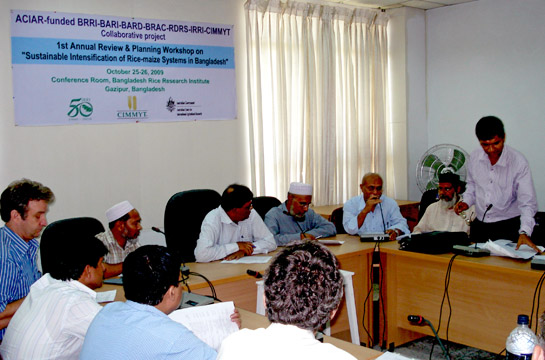 Partners of the “Sustainable intensification of rice-maize production systems in Bangladesh” met 25-29 October 2009 for the project’s first annual review—the program started in June 2008 and will run until 2013. Nearly 50 people attended the meeting held at the Bangladesh Rice Research Institute (BRRI) in Gazipur, Bangladesh. The Australian Center for International Agricultural Research (ACIAR) funds the project, which focuses on research and technology delivery for conservation agriculture (CA) and site-specific nutrient management (SSNM).
Partners of the “Sustainable intensification of rice-maize production systems in Bangladesh” met 25-29 October 2009 for the project’s first annual review—the program started in June 2008 and will run until 2013. Nearly 50 people attended the meeting held at the Bangladesh Rice Research Institute (BRRI) in Gazipur, Bangladesh. The Australian Center for International Agricultural Research (ACIAR) funds the project, which focuses on research and technology delivery for conservation agriculture (CA) and site-specific nutrient management (SSNM).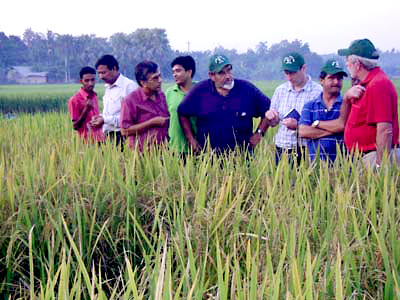 The last three days of activities took place in the research stations of BARI, BRRI, and the Bangladesh Academy for Rural Development (BARD), as well as at on-farm sites in Rajshahi and Comilla. Scientists spoke with farmers about the benefits of CA technologies and received feedback from the farmers about the different technologies tested in their fields as well as overall project activities. First year CA activities for maize primarily focused on seeding on flat land with a power tiller operated seeder (PTOS) and seeding with a bed former/planter on raised beds under reduced tillage. For rice, emphasis has been on direct-seeded rice with the PTOS, direct-seeded rice using a bed former/planter, and transplanting seedlings on raised beds.
The last three days of activities took place in the research stations of BARI, BRRI, and the Bangladesh Academy for Rural Development (BARD), as well as at on-farm sites in Rajshahi and Comilla. Scientists spoke with farmers about the benefits of CA technologies and received feedback from the farmers about the different technologies tested in their fields as well as overall project activities. First year CA activities for maize primarily focused on seeding on flat land with a power tiller operated seeder (PTOS) and seeding with a bed former/planter on raised beds under reduced tillage. For rice, emphasis has been on direct-seeded rice with the PTOS, direct-seeded rice using a bed former/planter, and transplanting seedlings on raised beds.